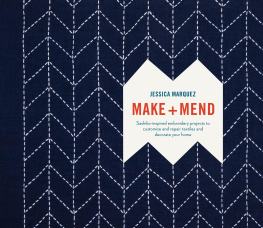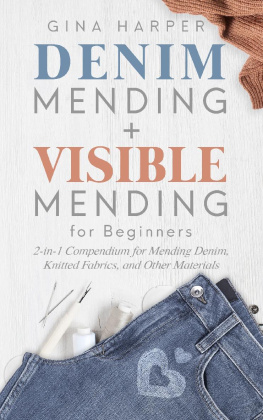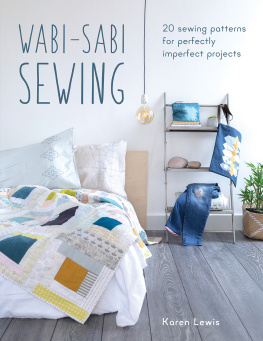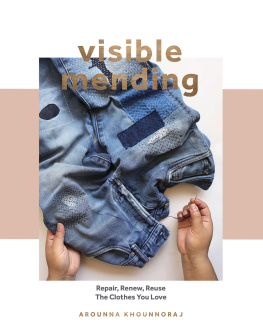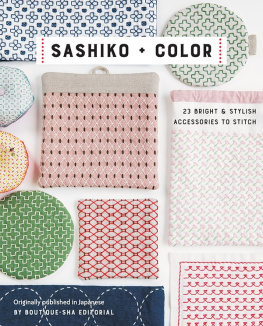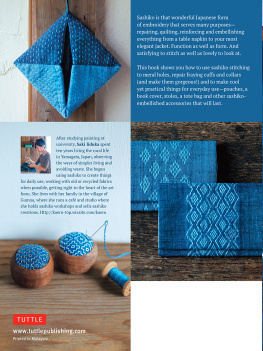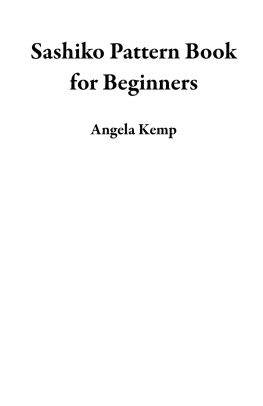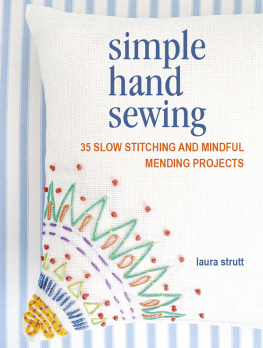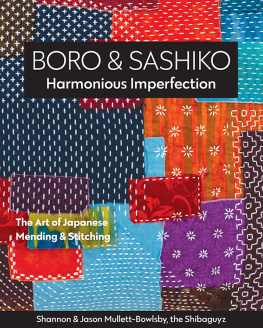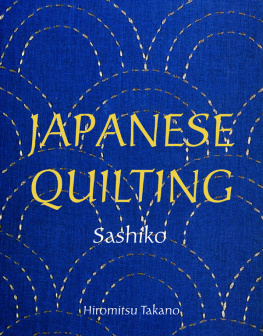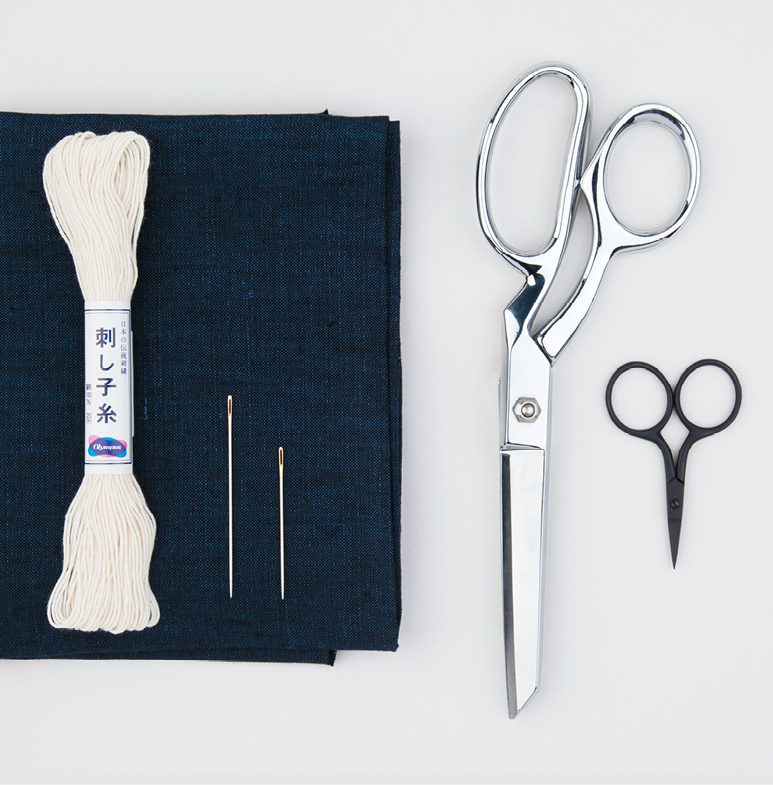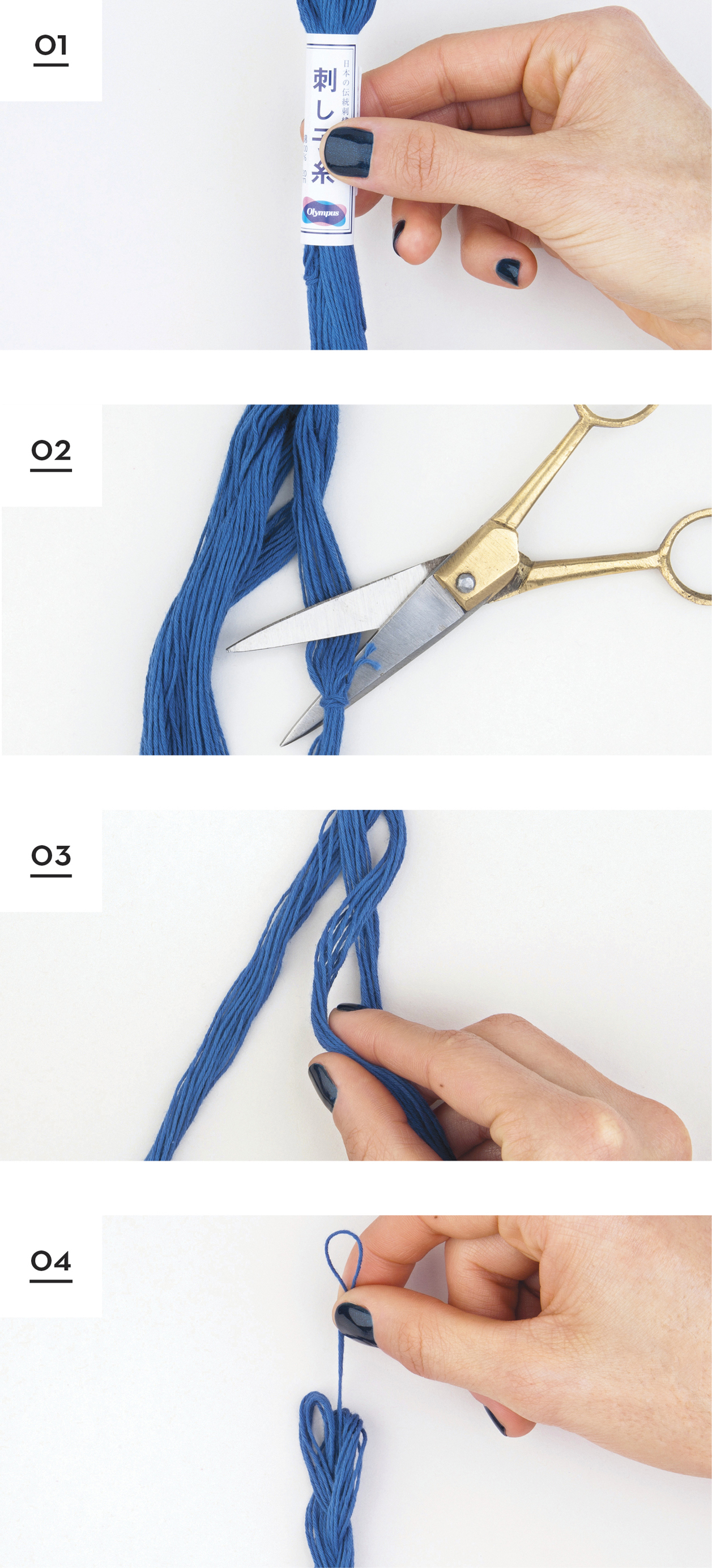Contents
JESSICA MARQUEZ is an author, photographer, teacher, content creator, and full-time creative maker behind the handmade Etsy shop Miniature Rhino. Jessicas work has been featured in dozens of print publications and countless blogs including Style Me Pretty, Design*Sponge, Apartment Therapy, and Refinery29.
RESOURCES
Sashiko Supplies
Kimono Momo
www.etsy.com/shop/kimonomomo
Purl Soho
www.purlsoho.com
Snuggly Monkey
www.etsy.com/shop/snugglymonkey
Stencils
The Stencil Company
www.quiltingstencils.com
Stencil 1
www.stencil1.com
Fabric
Alabama Chanin
www.alabamachanin.com
Cloud Nine Fabrics
www.cloud9fabrics.com
Gray Lines Linen
www.graylinelinen.com
Hell Gate Fabric
www.hellgatefabrics.com
Organic Cotton Plus
www.organiccottonplus.com
Natural Dyes
Audrey Louise Reynolds
www.alrdyeing.com
Botanical Colors
www.botanicalcolors.com
Dharma Trading Co.
www.dharmatrading.com
A Verb for Keeping Warm
www.averbforkeepingwarm.com/collections/natural-dyeing
Dried Herbs
Monterey Bay Spice Co.
www.herbco.com
Mountain Rose Herbs
www.mountainroseherbs.com/catalog/herbs
To download full-size patterns and templates visit Jessica Marquezs website, www.miniaturerhino.com.
FURTHER READING
Living with Pattern: Color, Texture, and Print at Home , by Rebecca Atwood
Mend It Better: Creative Patching, Darning, and Stitching , by Kristin M. Roach
Overdressed: The Shockingly High Cost of Cheap Fashion , by Elizabeth L. Cline
Scraps: Fashion, Textiles, and Creative Rinse , by Susan Brown and Matilda McQuaid
Simple Matters: Living with Less and Ending up With More , by Erin Boyle
Sustainable Fashion and Textiles: Design Journeys , by Kate Fletcher
The Ultimate Sashiko Sourcebook: Patterns, Projects and Inspirations , by Susan Briscoe
Getting Started
Start where you are. Use what you have. Do what you can.
Arthur Ashe
Make + Mend explores and celebrates contemporary sashiko, a world full of captivating patterns, colorful textiles, and modern mending techniques informed by historical practices. The projects are divided into two chapters inspired by the titles two main themes, make and mend. The Make chapter focuses on patterns in home textiles and clothing. The Mend chapter will sharpen your hand sewing skills with useful and gorgeous visible mending projects to repair and customize your clothing and textiles.
This Getting Started chapter introduces the foundations of sashiko, including all the tools and materials needed, as well as the process of drawing and transferring patterns and sashiko stitching. This chapter is a great reference while youre working on your projects. You may find yourself flipping back through these pages if you need a refresher.
Take your time and have patience with yourself as you explore these new techniques. Sashiko stitching and transferring patterns are skills that get easier with practice. I hope this useful, stress-free guide to getting started with sashiko allows you to have fun exploring these techniques.
TOOLS AND MATERIALS
Getting set up to sashiko stitch is easy and inexpensive. You dont need any fancy, expensive equipment or a lot of space to work or store materials.
Sashiko Essentials
Sashiko supplies are pretty simple: needles, scissors, thread, and fabric. In fact, you probably already have everything you need to start stitching now.
Needles
Sashiko needles are extra long so you can gather many stitches on them. They have a wide eye for easy threading and a sharp point. They come in sets of various lengths; a shorter needle is useful for handling curves.
You can also sew sashiko well with embroidery needles and crewel needles. They are not as long as sashiko needles but are just as sharp, and you can still gather many stitches. Just make sure the eye of the needle is wide enough for your thread.
Scissors
Youll need small, sharp embroidery scissors (snips) for cutting your thread, paper scissors for general use, and fabric scissors. Having a dedicated pair of fabric scissors helps keep them sharp.
USING SASHIKO THREAD
Sashiko thread is cleverly designed to be the perfect length for stitching. First youll need to prep the skein. Remove the paper band and unwind the threads (01), which will be in a continuous loop with a piece of thread tied around one end. Cut the threads on the side with the tie (02) and loosely braid the threads (03), pull lengths of thread from the top (looped end) of the braid as needed (04). Use a single ply of sashiko thread for thinner lines and double ply for bolder, thicker lines. For double ply, thread your needle, fold the thread in half, and tie a knot.
Sashiko thread is wound tightly, so as you stitch, you build up more tension, causing tangles. To help avoid frustrating thread snags, prep your thread for stitching: Before threading your needle, let the thread hang and smooth it with your fingers several times to release any tension. A thread conditioner () can help thread stay smooth, too. As you stitch, repeat the process of smoothing threads if they begin to twist and knot.
Thread
Traditional sashiko thread is tightly wound and nondivisible, and comes in several weights, or thicknesses. Large retail craft and sewing stores in the United States dont commonly carry sashiko thread, but you can find it in specialty shops and online (see Resources, ). For decorative projects, crochet and embroidery threads are inexpensive alternatives that are easy to find and come in lots of colors. They do fray much more quickly than sashiko thread, so make sure to cut shorter lengths of thread. Try using thread conditioner to protect your thread.
For mending projects, stick with sashiko thread. I also occasionally use hand-quilting and button-craft threads. These threads are very strongcrucial for mendingcome in a variety of colors, and are easy to stitch with. Never use sewing machine thread for repairs, which can easily snap.
Fabric
You can sashiko-stitch on just about any material. Sashiko is traditionally stitched on natural fibers like cotton, linen, hemp, and silk. Linen is easy to stitch and my favorite fabric for stitching in general. Made from flax, linen is a natural material with a low environmental impact (requires little water or pesticides to produce). Try a lower thread count linen so you can use the weave of the fabric to count your stitches if you want them evenly placed. I also like stitching on denim and canvas, because theyre sturdy and easy to work with. Whenever possible, avoid buying new man-made, synthetic fabrics like polyesters and nylon, which are more difficult to stitch on and made of plastic from fossil fuels and dont biodegrade, or choose vintage or recycled polyesters.
For mending projects, try to upcycle garments and fabrics. Start a scrap collection with sewing project remnants and beat-up clothes. For purchasing new fabrics, natural fibers and organic fabrics are a great place to start. In general, organic fabrics are made from fibers that were grown without pesticides and herbicides and require less water to produce, and efforts were made to reduce CO emissions during production. The organic label can be misleading because it doesnt take into consideration other sources of environmental impact. For example, is it produced with other chemicals, like harsh synthetic dyes? Organic is not a perfect solution, but its important to be conscious of the origin and production process of the materials we wear and use.

